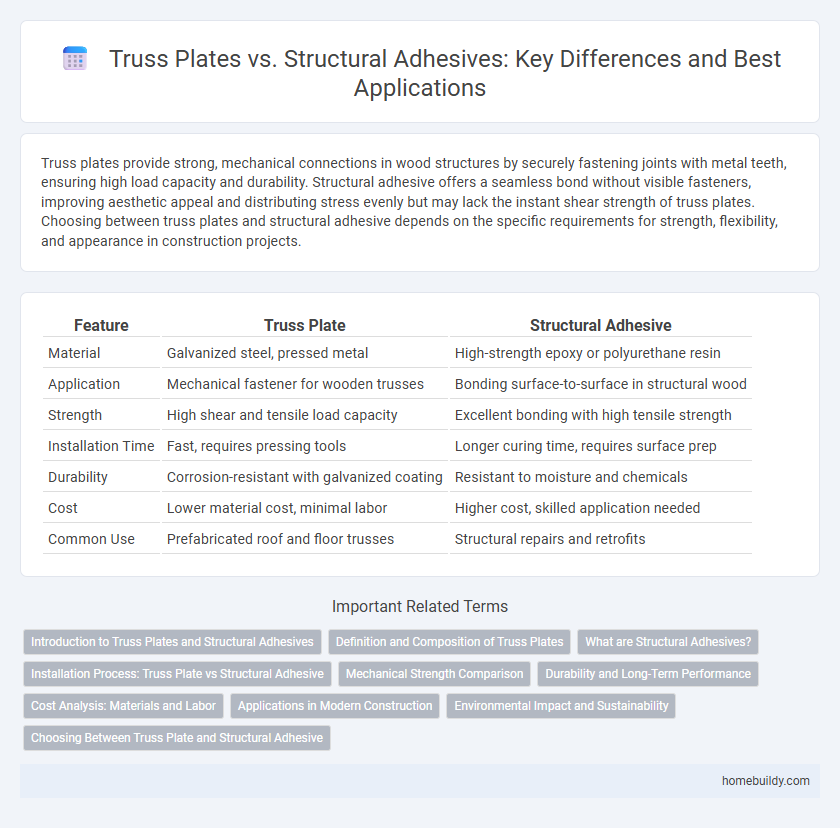Truss plates provide strong, mechanical connections in wood structures by securely fastening joints with metal teeth, ensuring high load capacity and durability. Structural adhesive offers a seamless bond without visible fasteners, improving aesthetic appeal and distributing stress evenly but may lack the instant shear strength of truss plates. Choosing between truss plates and structural adhesive depends on the specific requirements for strength, flexibility, and appearance in construction projects.
Table of Comparison
| Feature | Truss Plate | Structural Adhesive |
|---|---|---|
| Material | Galvanized steel, pressed metal | High-strength epoxy or polyurethane resin |
| Application | Mechanical fastener for wooden trusses | Bonding surface-to-surface in structural wood |
| Strength | High shear and tensile load capacity | Excellent bonding with high tensile strength |
| Installation Time | Fast, requires pressing tools | Longer curing time, requires surface prep |
| Durability | Corrosion-resistant with galvanized coating | Resistant to moisture and chemicals |
| Cost | Lower material cost, minimal labor | Higher cost, skilled application needed |
| Common Use | Prefabricated roof and floor trusses | Structural repairs and retrofits |
Introduction to Truss Plates and Structural Adhesives
Truss plates are metal connectors used to join wood components in structural frameworks, providing strong, rigid connections critical for load distribution in roof and floor trusses. Structural adhesives serve as bonding agents that create durable joints by chemically fusing surfaces, offering flexibility and resistance to environmental factors. While truss plates rely on mechanical fastening, structural adhesives emphasize bonding strength, each contributing uniquely to construction integrity.
Definition and Composition of Truss Plates
Truss plates are engineered metal connectors typically made from galvanized steel with multiple teeth designed to be pressed into wooden members to form structural joints, ensuring high load-bearing capacity and durability. Structural adhesives are polymer-based compounds composed of epoxy, polyurethane, or acrylic resins, formulated to bond timber surfaces chemically without mechanical fasteners. Unlike truss plates that rely on mechanical interlock through metal reinforcement, structural adhesives depend on chemical adhesion and curing processes to create strong, seamless wood joints.
What are Structural Adhesives?
Structural adhesives are high-strength bonding agents designed to join various materials such as metals, composites, and wood, offering a seamless and durable connection without mechanical fasteners. Unlike truss plates, which rely on metal connectors and mechanical fastening, structural adhesives distribute stress evenly across bonded surfaces and reduce weight by eliminating the need for metal joinery. Their applications span aerospace, automotive, and construction industries where strong, lightweight, and corrosion-resistant joints are critical.
Installation Process: Truss Plate vs Structural Adhesive
Truss plates require precise alignment and mechanical pressing during installation to ensure secure metal-to-wood connections, often demanding specialized equipment for proper embedding. Structural adhesive installation involves applying a uniform layer of adhesive followed by clamping or pressing to achieve bonding, typically allowing more flexibility and faster application in varied environments. The mechanical nature of truss plates provides immediate load transfer, whereas structural adhesive requires curing time to develop full strength.
Mechanical Strength Comparison
Truss plates provide superior mechanical strength due to their steel construction and multiple tooth design, enabling efficient load distribution and resistance to shear forces in timber joints. Structural adhesives offer strong bonding but generally lack the high shear strength and rigidity of truss plates, making them less suitable for heavy structural loads. Choosing truss plates ensures enhanced durability and stability in framing applications where mechanical robustness is critical.
Durability and Long-Term Performance
Truss plates offer superior durability and long-term performance compared to structural adhesives due to their high resistance to mechanical stress, moisture, and temperature fluctuations. Their metallic composition ensures consistent load-bearing capacity and prevents degradation over time, unlike adhesives that may weaken, crack, or lose bonding strength. This makes truss plates a preferred choice for structural applications where longevity and reliability are critical.
Cost Analysis: Materials and Labor
Truss plates typically offer a lower material cost compared to structural adhesives, with steel or galvanized metal plates priced between $0.10 to $0.30 per plate, while high-performance structural adhesives can exceed $15 per tube. Labor costs for installing truss plates usually involve quicker, mechanical press or roller application, reducing time spent per joint, whereas adhesive application requires surface preparation, curing time, and additional labor for clamping or jigging that increases overall labor expenses. When evaluating total cost, truss plates generally provide a more economical solution due to lower material prices and faster installation times in mass production environments.
Applications in Modern Construction
Truss plates offer rapid installation and high load-bearing capacity, making them ideal for prefabricated wood truss systems in residential and commercial buildings. Structural adhesives provide uniform stress distribution and enhanced resistance to environmental factors, often used in composite materials and metal-to-wood connections where flexibility and durability are critical. Modern construction increasingly combines truss plates with structural adhesives to optimize joint performance and accelerate assembly processes.
Environmental Impact and Sustainability
Truss plates often have a lower environmental footprint compared to structural adhesives, as they require less chemical processing and generate minimal off-gassing during installation. Steel truss plates are recyclable, contributing to sustainable construction practices by enabling material reuse and reducing landfill waste. Structural adhesives may involve volatile organic compounds (VOCs) and synthetic chemicals that pose environmental concerns and complicate disposal.
Choosing Between Truss Plate and Structural Adhesive
Choosing between truss plates and structural adhesive depends on the specific load requirements and construction conditions. Truss plates offer superior mechanical strength and durability for load-bearing joints in timber framing, while structural adhesives provide flexibility and can enhance airtightness or moisture resistance in certain applications. Evaluating factors such as joint type, environmental exposure, and installation speed helps determine the optimal connection method for structural integrity and longevity.
Truss plate vs Structural adhesive Infographic

 homebuildy.com
homebuildy.com